Delphi Archaeological Museum
The Museum of Delphi is considered among the three most important museums in Greece, together with the ones of the Acropolis of Athens and in Heraklion, Crete. What makes a visit to the Greek Museums in general, this one in particular, an unforgettable experience, is the fact that they usually exist on the very archaeological site(s), thus putting the exhibits in the surroundings in which they were initially established, in close relevance to their cultural and/or religious role.
The Delphi Museum first opened its doors tο the public in 1903; in the more than 100 years that have elapsed since then, it has been recognized as one of the most important museums in Greece. It has undergone many renovations during this time and four different exhibitions, each reflecting the scientific concepts and artistic standards as they evolved through the 20th century. The quality of the exhibits, though, has always been the main advantage of this Museum.
According to Rosina Colonia, (Delphi Ephorate of Antiquities) “… the Delphi exhibits speak for themselves: they have the power to command respect and captivate the visitor, inviting him or her to admire them, and leaving this visitor with the memory of their charm and the enigma surrounding them. Even though the exhibits on display today constitute no more than a small but representative part of the dedications seen by Pausanias at Delphi, and an even smaller part of the many more that inundated the sanctuary during the years of its heyday, they indisputably continue to delight people with their wealth, variety and beauty. …Delphi has been included in archaeology textbooks, it has adorned art books; some of the Delphi finds, such as the Treasury of the Siphnians, are landmarks in the history of ancient Hellenic art, while others, even though more than one hundred years have elapsed since they came to light, continue to be a focal point of scholarly discussions even today, owing to unanswered questions regarding their identity and interpretation. But above all, they still chaim the broad public who flock, like ancient pilgrims, to admire the monuments of Delphi”. (Quotation ©: John S. Latsis Public Benefit Foundation)
Photos will be gradually added in the near future
Select Page of the Album:
Click on any of the pictures to enlarge.
The Siphnian Treasury (Hall V)Next to the austere Doric buildings dedicated to the sanctuary of Delphi by cities of mainland Greece, the Siphnian treasury represents the style and workmanship of the Aegean islands and eastern Greece, as well as the richly ornate Ionic order. The architectural remains permit the restoration of this treasury in detail. Moreover, this is one of the few monuments that can be dated precisely, since its construction relates to a historic event described by Herodotus and foreseen by Pythia in the oracle she gave to the Siphnians. After their unsuccessful rebellion against tyrant Polykrates in 524 BC, Samian fugitives plundered Siphnos. The treasury obviously pre-dates the plundering.
The construction of this treasury entirely of marble was a token of gratitude to Apollo on the part of the small Cycladic island, which at that time was flourishing financially due to the gold and silver mines. The treasury was luxurious indeed, as shown by the excessive sculpted decoration of the building from top to base. Relief bands with superb decorative patterns (mouldings, palmettes, lotus flowers, rosettes), marble lion-heads at the eave-gutters, figurative frieze, sculpted pediments and apex figures, all contribute to an extravagant manifestation of the ostentatious Ionic order. It is on the facade, however, that the domination of sculpture reaches its peak: the usual two columns in-antis supporting the epistyle are here replaced by a couple of Korai, similar to the Akropolis Korai of Ionic origin. So, in about 525 BC the caryatids of the Siphnian treasury foreshadow the Erechtheion porch.
The first scholars who studied the treasury observed slight variations in the technique of carving and therefore considered the frieze to be the work of two groups of craftsmen with two master sculptors respectively in charge. The artist responsible for the north and east sides had been influenced by the progressive workshops of Chios and Attica, whereas the master of the west and south sides was conservative and probably trained in art schools of the Asia Minor coast, especially Ionia.
Figures in battle and duel scenes, in particular, display unlimited diversity. The dramatic, epic narration on the marble surface is hardly monotonous thanks to the resourceful differentiation between garments, moves and stances, with no repetition whatsoever. The brightly painted parts of the frieze, along with some details (e.g. weapons) emphasized by inlaid metal, contributed to the impressive, glowing visual impact of the entire composition. Written in paint on the background of the sculpted surface were some of the names of the figures.
This Treasury was in the form of a Prostyle temple, with the statues of two Korae (young girls) replacing the two columns between the pilasters on each side supporting the Architrave (Epistyle). The East Pediment is the only one that has been preserved, decorated with the figure of Heracles trying to steal the Delphic Tripod from Apollo, while Zeus is trying to intervene and settle the quarrel pecefully. This monument was also the first one to use fallen or bending figures to fill in the decoration at the edges of the pediment.
The sculpted friezes decorating all four sides of the building depicted various scenes inspired from the Greek Mythology. The South side depicts scenes complementary to the East Frieze, where the gods watch the Hellenes attack Troy. The West Frieze shows the narration of the Judgement of Paris when he was asked to select the most beautigul goddess from among Aphrodite, Athena and Hera. It depicts three groups of chariots (related to the the tree competing goddesses). The North Frieze depicts the Gigantomachy, to which the next album page is allocated.
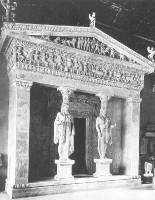
Reconstruction of the Siphnian Treasury Façade
credit: teachers.sduhsd.k12.ca.us |
|
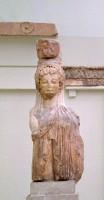
Upper torso of the south caryatid of the Siphnian treasury
She is wearing an oblique ‘himation’ over a chiton with thin wavy pleats. Holes on the wavy hair-locks round the forehead served probably the insertion of either decorative metal attachments or perhaps curls of marble. The round outline of her face, the almond-shaped eyes and the rendering of her hair suggest a sculptor of insular origins, trained in the cultural centers of Ionia/Asia Minor. On top of caryatid's head a ‘kalathos’ is carved in relief with a Dionysian subject-matter showing Silens and Maenads. A lesbian moulding runs around the base of the kalathos.
It is believed that the caryatid was made by the sculptor responsible for the east and north sides of the frieze of the Siphnian treasury, whereas the kalathos and the echinos were the work of the artist who carved the west and south sides. |
|
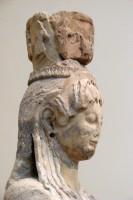
Head of the south caryatid of the Siphnian treasury |
|
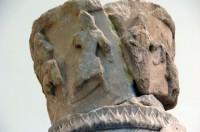
Head of the south caryatid of the Siphnian treasury
The ‘kalathos’ in relief on top of caryatid's head. It is based on a Dionysian subject-matter showing Silens and Maenads. A lesbian moulding runs around the base of the kalathos. |
|
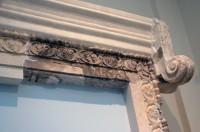
The treasury of the Siphnians: Decoration of the façade
Relief bands with superb decorative patterns (mouldings, palmettes, lotus flowers, rosettes), marble lion-heads at the eave-gutters, figurative frieze, sculpted pediments and apex figures (See also following photos) |
|
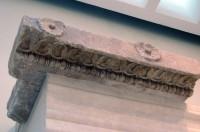
The treasury of the Siphnians: Decoration of the façade
Relief bands with superb decorative patterns (mouldings, palmettes, lotus flowers, rosettes), marble lion-heads at the eave-gutters, figurative frieze, sculpted pediments and apex figures (See also following photos) |
|
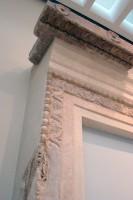
The treasury of the Siphnians: Decoration of the façade
Relief bands with superb decorative patterns (mouldings, palmettes, lotus flowers, rosettes), marble lion-heads at the eave-gutters, figurative frieze, sculpted pediments and apex figures (See also following photos) |
|
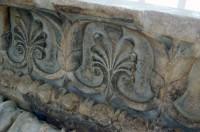
The treasury of the Siphnians: Decoration of the façade
Relief bands with superb decorative patterns (mouldings, palmettes, lotus flowers, rosettes), marble lion-heads at the eave-gutters, figurative frieze, sculpted pediments and apex figures (See also following photos) |
|
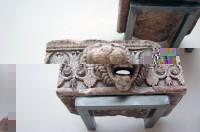
The treasury of the Siphnians: Decoration of the façade
Part of the marble rain gutter with relief palmettes and lotus blossoms that are interrupted by the spout through which water drained from the roof (See also following photos) |
|
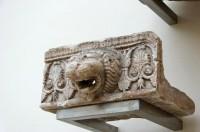
The treasury of the Siphnians: Decoration of the façade
Part of the marble rain gutter with relief palmettes and lotus blossoms that are interrupted by the spout through which water drained from the roof (See also following photos) |
|
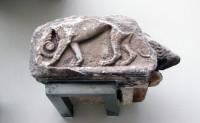
The treasury of the Siphnians: Decoration of the façade |
|
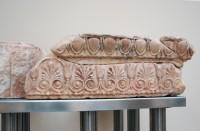
The treasury of the Siphnians: Decoration of the façade
Relief bands with superb decorative patterns (mouldings, palmettes, lotus flowers, rosettes), marble lion-heads at the eave-gutters, figurative frieze, sculpted pediments and apex figures. |
|

The east pediment of the Siphnian treasury (525 BC.) Please scroll to see it all!
Apollo and Heracles disputing about the Delphic tripod.
|
|

East side of the frieze of the Siphnian treasury (525 B.C.) Assembly of the gods.
This is actually part of the frieze. The gods are seated, watching the battle between the Trojans and the Greeks, a scene that succeeds this one to the right. To the left are the pro-Trojan gods, Ares fully armed, two goddesses and Apollo. After the not preserved part, there follow the pro-Greek gods: Athena, Hera and, possibly, Thetis. The gap in the middle is due to that the two photos merged to make this one did not cover the whole length of the scene; there are some 10 cm (3-4 inches) more of the unsculpted part in between the two preserved parts of this scene. |
|
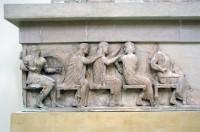
East side of the frieze of the Siphnian treasury (525 B.C.) Assembly of the gods.
The pro-Trojan group of gods |
|
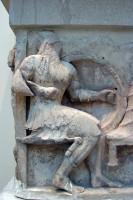
East side of the frieze of the Siphnian treasury (525 B-C). Assembly of the gods (Detail). |
|
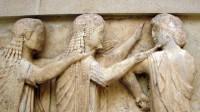
East side of the frieze of the Siphnian treasury (525 B.C.) Assembly of the gods (Detail).
The two goddesses have a conversation with Apollo, who has turned round on his seat to face them. |
|
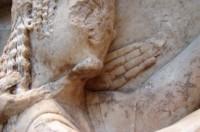
East side of the frieze of the Siphnian treasury (525 B-C): Assembly of the gods (Detail) |
|
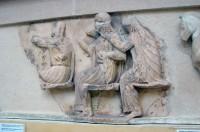
East side of the frieze of the Siphnian treasury (525 B.C.) Assembly of the gods.
The pro-Greek group of gods. This photo and the previous one should be considered as a whole (Please also see the photo synthesis above) |
|
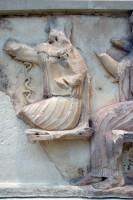
East side of the frieze of the Siphnian treasury (525 B-C). Assembly of the gods (Detail). |
|
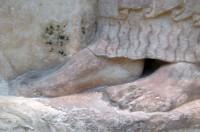
East side of the frieze of the Siphnian treasury (525 B-C): Assembly of the gods (Detail) |
|
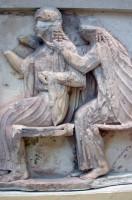
East side of the frieze of the Siphnian treasury (525 B-C). Assembly of the gods (Detail). |
|

East side of the frieze of the Siphnian treasury (525 B-C). Greeks and Trojans fighting over a dead hero.
This is the sculpted continuation of the same frieze |
|
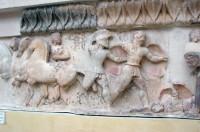
East side of the frieze of the Siphnian treasury (525 BC.). Greeks and Trojans fighting over a dead hero. (Detail) |
|
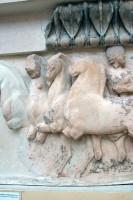
East side of the frieze of the Siphnian treasury (525 BC.). Greeks and Trojans fighting over a dead hero. (Detail) |
|
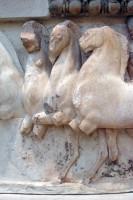
East side of the frieze of the Siphnian treasury (525 B-C). Greeks and Trojans fighting over a dead hero. (Detail) |
|
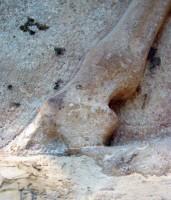
East side of the frieze of the Siphnian treasury (525 B-C). Greeks and Trojans fighting over a dead hero. (Detail) |
|
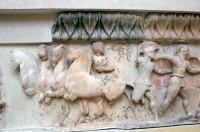
East side of the frieze of the Siphnian treasury (525 BC.). Greeks and Trojans fighting over a dead hero. (Detail) |
|
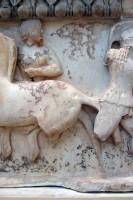
East side of the frieze of the Siphnian treasury (525 B-C). Greeks and Trojans fighting over a dead hero. (Detail) |
|
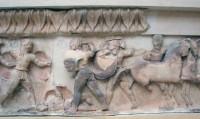
East side of the frieze of the Siphnian treasury (525 BC.). Greeks and Trojans fighting over a dead hero. (Detail) |
|
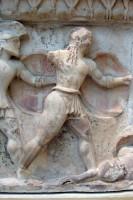
East side of the frieze of the Siphnian treasury (525 B-C). Greeks and Trojans fighting over a dead hero. (Detail) |
|
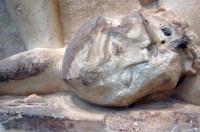
East side of the frieze of the Siphnian treasury (525 B-C). Greeks and Trojans fighting over a dead hero. (Detail) |
|
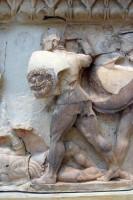
East side of the frieze of the Siphnian treasury (525 B-C). Greeks and Trojans fighting over a dead hero. (Detail) |
|
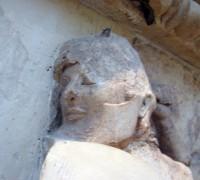
East side of the frieze of the Siphnian treasury (525 B-C). Greeks and Trojans fighting over a dead hero. (Detail) |
|
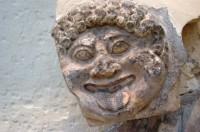
East side of the frieze of the Siphnian treasury (525 B-C). Greeks and Trojans fighting over a dead hero (Detail) |
|
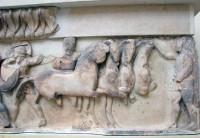
East side of the frieze of the Siphnian treasury (525 BC.). Greeks and Trojans fighting over a dead hero. (Detail) |
|
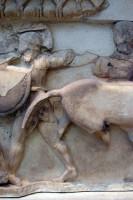
East side of the frieze of the Siphnian treasury (525 B-C). Greeks and Trojans fighting over a dead hero. (Detail) |
|
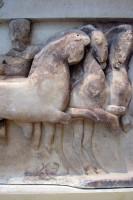
East side of the frieze of the Siphnian treasury (525 B-C). Greeks and Trojans fighting over a dead hero. (Detail) |
|
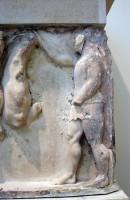
East side of the frieze of the Siphnian treasury (525 B-C). Greeks and Trojans fighting over a dead hero. (Detail) |
|
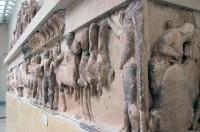
East side of the frieze of the Siphnian treasury (525 BC.). Greeks and Trojans fighting over a dead hero. (The whole frieze photographed from its end)
The beginning of the North frieze, depicting the Gigantomachy, can also be seen. The North frieze itself can be seen in detail in our next album page. |
|

Siphnian Treasury West Frieze Panorama (Please scroll the photo to see it all)
TAccording to the myth this story started at the wedding of Thetis and Peleus, when Eris (Discord), in revenge for not being invited, tossed a golden apple among the wedding guests on which was written: 'For the fairest'. Immediately a quarrel broke out between Aphrodite, Athena and Hera all of whom claimed the apple; Zeus assigned Paris, the prince of Troy, to be the judge. The few figures preserved from the west side of the frieze lead to the assumption that here the subject was the prementioned judgment of Paris at the beauty contest among Athena, Aphrodite and Hera. He voted for Aphrodite and, in return, earned the most beautiful woman in the world, Helene of Sparta, wife of king Menelaos. It was her abduction that triggered the Trojan War. First of the contestants is goddess Athena, who appears as if she is mounting her winged chariot. Hermes frames the scene to the left. Aphrodite is graciously stepping off her own chariot, touching her necklace with a coquettish gesture. The missing part of the frieze would feature Hera, ready for departure after her unsuccessful participation. Last would be the judge Paris. Thus the theme on the west side constituted an introduction to the theme on the east side, related to the Trojan War, which is photographed above. |
|
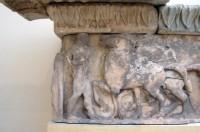
Siphnian Treasury West Frieze: Hermes in front of the winged horses on Athena's chariot.
The beginning of the west frieze of the Treasury of the Siphnians, representing the judgement of Paris, i.e. the contest judged by Paris, to determine which of the goddesses Athena, Aphrodite and Hera was the fairest. |
|
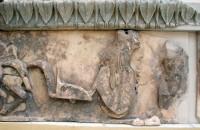
Siphnian Treasury West Frieze: Winged Athena is mounting her chariot...
...obviously to depart defeated after the unequal competition with Aphrodite. She is wearing her characteristic aegis with the tassels in the form of coiled snakes around the edge. |
|
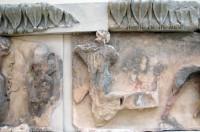
Siphnian Treasury West Frieze: Female figure descending from a chariot with studied grace.
Detail from the scene of the Judgement of Paris on the west frieze of the Treasury of the Siphnians. This is the central figure of the frieze on the façade of the building with the two caryatids; it has been interpreted as Aphrodite descending from her chariot holding the reins or arranging her necklace in a coquettish gesture. She is wearing a diadem in her hair and her ear is covered by an octagonal ornament.
In any event, it was the movement of this female figure from the west frieze of the Treasury of the Siphnians that poet George Seferis had in mind when writing his impressions of the Museum of Delphi: "A vibrant thigh, as the knee bends for a woman to descend from a chariot. Such fragments from a life that was once whole are stirring bits very familiar to us, at one moment our own, and then mysterious and inaccessible."
(G, SEFERIS, Essays, "Delphi", 1961) |
|
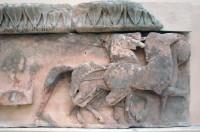
Siphnian Treasury West Frieze: The horses dragging the chariot of Aphrodite's |
|
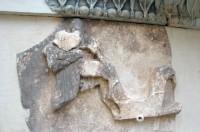
Siphnian Treasury West Frieze: Hera is getting on her chariot
Like Athena, in the beginning of the Frieze, goddess Hera is leaving the beauty contest |
|

The south frieze of the Siphnian treasury (525 B.C.) Equestrian procession (Please scroll to see it all!)
The fragmentary state of the south frieze slabs prevents its restoration and the certain identification of its theme. A procession with four-horse chariots, riders and horses unfolds from left to right. Perhaps the theme of the frieze concerned mythical abductions of women by heroes and demigods, such as the rape of Hippodamia by Pelops and that of Phoebe and Ilaera, daughters of Leucippus, by the Dioscuri. The chariots are carrying young women and are accompanied by riders.
Two horses follow the chariot, galloping sedately. They are led by a nude man, perhaps one of the two Dioscuri, who is riding one horse and holding the second one by the reins. The horses are rendered naturalistically in terms of the folds of the skin on the neck and knees. The human figures are flat, i.e. more drawn than sculpted, a feature that lends the whole scene a painterly character. This is visible on the west frieze as well, in contrast with the sculpturality and narrative spirit that distinguishes the other two sides with the Gigantomachy and the assembly of the gods. For this reason, two artists’ workshops are believed to have worked on the frieze with the supervision of two sculptors who, in addition to the new material, the island marble, brought to Delphi the art of Ionia, but with different traditions and influences. (www.latsis-foundation.org) |
|
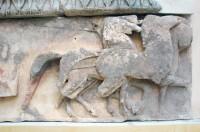
The south frieze of the Siphnian treasury (525 B.C.) Equestrian procession |
|
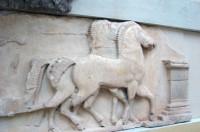
The south frieze of the Siphnian treasury (525 B.C.) Equestrian procession
Scene with a four-horse chariot. The horses have come to a halt in front of an altar. On the left, the hand of the charioteer can be discerned and the ends of the reins he was holding. |
|
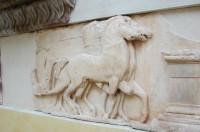
The south frieze of the Siphnian treasury (525 B.C.) Equestrian procession
Scene with a four-horse chariot. The horses have come to a halt in front of an altar. On the left, the hand of the charioteer can be discerned and the ends of the reins he was holding. |
|
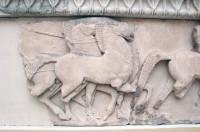
The south frieze of the Siphnian treasury (525 B.C.) Equestrian procession |
|
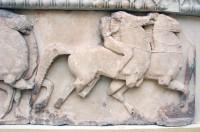
The south frieze of the Siphnian treasury (525 B.C.) Equestrian procession |
|
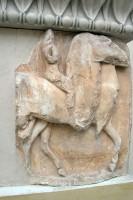
The south frieze of the Siphnian treasury (525 B.C.) Equestrian procession
The final group of horses |
|
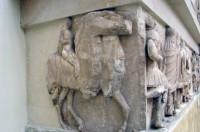
The south frieze of the Siphnian treasury (525 B.C.) Equestrian procession
The end part of the south frieze: two horses and a horseman. |
|
Select Page of the Album:
|
|



